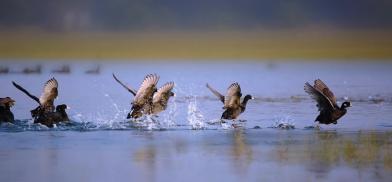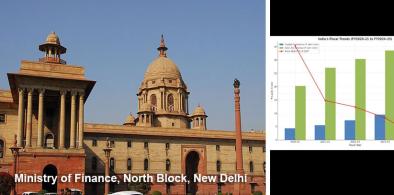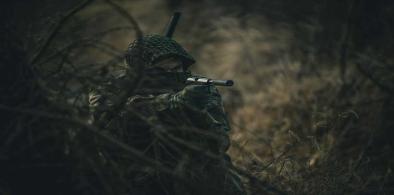How human folly killed a famous natural lake in Pakistan
The Narerri Lagoon along the coast of the Arabian Sea, in the extreme south of district Badin in Sindh province, has been one of the few famous natural lakes of the province which is a recognized Ramsar wetland site since 2001, writes Muhammad Abbas Khaskheli for South Asia Monitor

Its dawn here in village Deenar Khan Talpur, a small rural settlement along the coast of Arabian Sea in Pakistan’s Sindh province’s district Badin. Young Ramzan Khaskheli and his 80-year-old father Arab Khaskheli are laying their fishing nets, collecting drinking water bottles and one-time meal on a motorbike and saying goodbye to their families as they make their way to fish at Narerri Lake.
The distance between this village and the lake is nearly 17 km, which may sound close for many of us, but the first challenge for the local fishermen here is to cross the first 15 km of barren fields. Anyone who wants to go to the lake has to pass through this rough and tough piece of land. It takes one hour or sometimes more to pass this desolate route, which is a wilderness that has no human population, no trees, and, most importantly, no water.
“This wilderness can finish off those who are not aware of the exact route. There are many nerve-racking stories of poor fisherfolks and herders who have died of thirst in this barren route. Recently, a shepherd boy of village Kirio Bhandari lost his way here, and then after a few days’ villagers found his body,” Ramzan Khaskheli said as he drives on his motorbike.
Ramzan and his father, after crossing that barren piece of land, reach Sadabahar point of this lake. He stops the bike and without wasting any time enters the water to confirm how much fish they can get if they fix their net at that point, while his father stays back at the bank. He returns and confirms to his father about catching “enough fish” from that point. They both enter the lake and start fixing nets and return after half an hour. Now they have to just wait. So they wander around looking for a shelter that can protect them from the scorching heat. But sadly there is no place as the entire area, except for a few dilapidated tourist huts constructed by the Sindh government’s Culture, Tourism, and Antiquities Department in 2017 with the view to renovating the area for tourists visiting the lake, lies in shambles.
“Earlier, my four brothers and their 15 sons used to come here for fishing. But after the cyclone of May 1999, they all stopped coming here because the quantity of fish in this lake drastically decreased,” Arab said.
“Since then some of them are working as labourers in nearby towns while others are farmers. They all would have died of hunger if they had continued this occupation,” he added while taking a sip of water from the bottle.
He continued, “It’s not the story of our family alone. More than 2,000 fishermen of surrounding 30 villages who used to depend on this lake have also quit fishing. The main reason has been the insufficiency of fish and prawns in the lake, for which it was once famous in the entire coastal belt.”
His son added: “During that violent cyclone, the Tidal Link canal on Left Bank Outfall Drain (LBOD) broke and consequently the seawater rushed into the lake and nearby villages and washed everything that came on its way.” LBOD is a drainage canal in Pakistan. Built between 1987 and 1997, the canal was to collect saline water, industrial effluents and Indus river basin floodwater from more than two million hectares of land of Shaheed Benazirabad, Sanghar, Mirpurkhas and Badin districts located in Nara river basin into the Arabian Sea. But the canal overflowed in 2003 and 2011, causing widespread flooding that it was meant to prevent.
“Moreover, regular discharging of untreated effluent of different sugar mills through disastrous Ameer Shah Drain (originally called Phuleli-Guni Outfall Drain) and Karo Ghonghro Drain into this lake also made the survival of aquatic life extremely difficult. Hence the lake started dying,” Arab said.i
The Narerri Lagoon along the coast of the Arabian Sea, in the extreme south of district Badin in Sindh province, has been one of the few famous natural lakes of the province which is a recognized Ramsar wetland site since 2001. It’s a natural habitat for a variety of fish species, crabs, and migratory birds for years. It is also a source of earning for the poverty-stricken fisher folks of Sindh’s remotest districts. It was once stretched over an area of 2,540 hectares but since the seawater started entering owing to A2 cyclone (1999), no one is sure about its exact covered area because the small creeks in and around the lake where once the local fishing communities used to live on have been lost to the sea. Now it is just seawater and it is hard to even find the marks of any lake here.
Fish scarcity
Trash fishing (marine fish having little or no market value) practice has been leading to the extinction of many fish species: The major reason behind fish scarcity in the coastal belt of Sindh is trash fishing which has been adopted by local fisherfolk in both seawater and freshwater bodies. According to the Sindh Fisheries Act 1980, it’s a crime but neither fishermen nor the provincial fisheries department take it seriously in following and implementing the Act. Consequently, a great number of fish species are threatened. The 50-Mori canal is the only freshwater channel, which discharges into this lake, but unfortunately, it remains dry most of the time due to the unavailability of water in the provincial irrigation system. But when it flows local fishermen start trash fishing at its confluence with Narerri Lake.
On average, local fishermen catch 200 to 500 kg of trash fish monthly at this lake. Moreover, the nets - Bolu and Gujo (mesh-size fishing nets) - they use to catch trash fish are also prohibited. Authorities, however, are not concerned with this illegal practice which has caused the extinction of many fish species.
Dying prawn business: At some distance from Sadabahar point of Narerri lake, there is a prawn and crab collection hut/point locally called ‘Kanto’ in the Sindhi language where prawns and crabs are collected from fishermen and sent to the Karachi fish market for selling. There are around 10 fishermen employed by a private contractor here at this single point. The manager, Rajab Mallah, collects prawn from fishermen at the rate of 200 PKR to 250 PKR per kilogram, and then sells them at 450 PKR to 500 PKR per kilogram.
About his dying business, he said, “I am in this business for the past 30 years. Over the years, the business has drastically slowed down. The cyclone of 1999 proved to be the last nail in the coffin for the thousands of poor fishermen of this region. I personally know more than 1,000 fishermen who have said goodbye to this business and are working as labourers now in different towns.”
“This was a natural lake on the edge of the mighty Arabian Sea. The intrusion of the seawater plus the discharge of untreated water from the sugar mills created all the havoc. The lake and its inhabitants started dying. Earlier, we used to catch huge fishes but nothing is left now,” he sighed.
A local fisherman, Soomar Mallah, who came here to sell prawns, said, “I have been coming to this lake and catching prawns for the last 35 years. We were happy before 1999. In those days, I used to sell 20 to 30 kg of prawns daily but since the violent cyclone, I now only sell 3 to 5 kg prawns per day.”
A cyclone of the past has proved to be disastrous for the Sindh coastline: It’s a reality that the A2 cyclone changed the geography of the entire coastal belt of Sindh including Narerri Lake. There used to be more than 30 lakes in the coastal belt of Sindh, which include Pateji, Haleji, Jhubho, Cholri, Sanhro, Mehro, and others. Some of them were sweet water lakes, which have now either dried up due to the unavailability of sweet water or destroyed by discharging poisonous substance through outfall drains, while in others seawater has entered.
Abubakar Shaikh, an environmental researcher from Badin and who has carried out several research studies on the many lakes of Sindh, including Narerri Lake, said “Cyclone, flood, sea intrusion, discharging of poisonous waste of mills, unavailability of sweet water and excessive fish and bird hunting are all threats that contributed in Narerri Lagoon’s devastation. Historically, the coastal belt of Sindh has always faced natural disasters. In 1819, a lethal earthquake rocked this entire area which was followed by different small scale earthquakes between 1886 and 1903. We can find the record of 54 cyclones that hit Sindh’s coast between 1864 and 1889. After the inception of Pakistan, it witnessed a violent cyclone in 1964 and then in 1999.
“The first time, I ever visited this lake was in the winter of 1988. Those were flourishing days of this lake as I found more than 200 families of fisherfolk living along the Narerri Lagoon. They had enough fish and prawns to catch, sell, and eat. Later on, when I visited the lake again in 2009, I couldn’t even recognize that it’s the same Narerri I visited way back in 1988 because everything was in tatters. Only 10 to 12 families could have stayed back here, and even they were also thinking of quitting fishing and migrating somewhere else. There was a wilderness everywhere as the seawater had invaded the green lands around the lake.”
LBOD was a mega failure: Before 1984, the coastal line of Thatta and Badin districts was famous for its lakes and fishes but in the same year the most disastrous project - a mega failure - in Pakistan’s history, the Left Bank Outfall Drain, was started. The project was started by Water and Power Development Authority (WAPDA) with the funding of the World Bank and Asian Development Bank and the slogan was to change the lives of Sindh’s coastal communities. The project promised to deliver positive impacts on the local environment and on agricultural lands but nothing like that happened.
The last portion of the LBOD namely Cholri Weir, which was connecting LBOD with the sea collapsed in 1998, while the other portion of that huge engineering set up namely Tidal Link broke a year later in 1999 cyclone, and consequently all the seawater rushed in nearby settlements and water bodies.
According to experts, it was a "big" mistake of the engineers, who designed it. The World Bank’s inspection panel also admitted it too in 2006. But it was too late by then because everything was devastated and nothing was left.
(The writer is a Pakistan-based columnist on environmental and social issues. The views expressed are personal. He can be reached at abbaskhaskheli110@gmail.com)




















Post a Comment